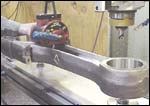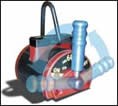Learn Before Lifting
A safety feature on this magnetic lifter determines whether the load falls within the safe capacity of the device.
Share





Lifting devices generally have clear ratings specifying the maximum load they can safely carry. However, the loads themselves don’t come with similar labels. Few of the sorts of loads that are moved in a production environment are weighed before the load is lifted. So how can an operator be assured that a particular load falls within the safe capacity of the device?
An answer to this question is built into the “Eagle Lift” line of hand-controlled permanent magnetic lifters from Alpha Workholding Solutions (Hartland, Wisconsin). These lifters offer a feature that the company calls its “Test Talon.” Between the “on” and “off” settings of the control handle, the lifter has an intermediate setting called “test.” At this setting, the magnet is engaged, but without the additional holding force that achieves the 3:1 safety factor. The force of the magnet at this setting is the rated force alone. The user tests the load by trying to lift it slightly. If the weight holds, then it is within the rating of the magnet. The user then moves the handle all the way to the “on” position to engage the safety margin, at which point the load can be moved with confidence.
That confidence was the main reason for developing this feature, national sales manager Bradley Evans says. The Test Talon aims to help employers who want to realize an environment in which operators can know concretely whether they are working within safe parameters. The feature is available on lifters offering safe working load ratings up to 5,000 pounds.
Related Content
-
Parts and Programs: Setup for Success
Tips for program and work setups that can simplify adjustments and troubleshooting.
-
Rail Manufacturer Moves Full Steam Ahead with Safe, Efficient Workholding Solution
All World Machinery Supply paired a hydraulic power unit with remote operating capabilities in a custom workholding system for Ahaus Tool & Engineering.
-
Using Automation to Reduce COGS and Stay Globally Competitive
Decade-long, multiphase automation investments lower operating costs and maintain technology lead in an increasingly competitive global market.























